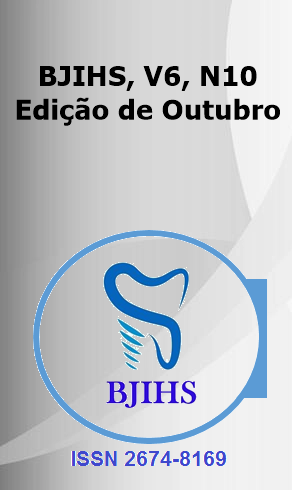Abstract
Introduction: Hyperadrenocorticism (HAC) is one of the most common endocrinopathies in dogs, characterized by high levels of circulating glucocorticoids, mostly affecting middle-aged to elderly dogs. Its causes include excessive production of glucocorticoids by the pituitary gland or adrenals, and it can be induced iatrogenically by prolonged use of glucocorticoids. Objective: To review the pathophysiology, diagnosis and treatment of hyperadrenocorticism in dogs, emphasizing the importance of early diagnosis and ongoing management of the disease. Methodology: A narrative literature review was conducted with searches in databases such as PubMed, ScienceDirect, Google Scholar and Scielo, covering studies between 2004 and 2024. Articles that dealt directly with the diagnosis, treatment and clinical manifestations of CAH in small animals were included. Results and Discussion: CAH is a disease that can be pituitary-dependent (HAC-HD) or adrenal-dependent (HAC-AD). Diagnosis is made by laboratory tests, such as the dexamethasone suppression test and ACTH stimulation, as well as imaging tests such as ultrasound and MRI. Treatment can be clinical, with the use of drugs such as Trilostane and Mitotane, or surgical, such as adrenalectomy for unilateral adrenal tumors. Clinical signs include polyuria, polydipsia, polyphagia, alopecia and abdominal distension, often confused with symptoms of ageing. Conclusion: CAH is a chronic condition that requires early diagnosis and ongoing treatment to control cortisol levels and improve dogs' quality of life. Veterinary follow-up is essential to adjust therapies and prevent complications.
References
ALENZA, D. P. Hiperadrenocorticismo: Are we over-diagnosing it. Proceedings of the Southern European Conference & Congreso Nacional AVEPA. Espanha, 2011.
BENEDITO, G. S.; ROSSI, E. M.; CAMARGO, M. H. B. Hiperadrenocorticismo em cães: Revisão de Literatura. Revista de Ciência Veterinária e Saúde Pública, v. 4, n. 1, p. 127-138, 2017
BLOIS, S. L.; DICKIE, E. ; KRUTH, S. A.; ALLEN, D. G. Multiple endocrine diseases in dogs: 35 cases (1996–2009). Journal of the American Veterinary Medical Association, v. 238, n. 12, p. 1616-1621, 2011. DOI: 10.2460/javma.238.12.1616.
CRIVELLENTI, S. B.; MALTA, C. A. S. A endocrinologia da poliúria e da polidipsia. Revista de Literatura, p. 22-25, 2015.
FELDMAN, E. C.; NELSON, R. W. Canine Hyperadrenocorticism. In: FELDMAN, E.; NELSON, R. Canine and Feline Endocrinology and Reproduction. 3. ed. Philadelphia: W.B. Saunders, 2004. p. 252-357.
FELDMAN, E. C.; ETTINGER, S. J. Hyperadrenocorticism. In: FELDMAN, E. C.; ETTINGER, S. J. Textbook of Veterinary Internal Medicine. 7. ed. Philadelphia: W.B. Saunders, 2010. p. 1460-1487.
FERREIRA FILHO, D. F.; FIUZA, R. F.; LEITE, A. K. R. Síndrome de Cushing iatrogênica em cão: Relato de caso. Revista Científica Eletrônica de Medicina Veterinária, v. 21, 2013.
FELDMAN, E. C. Hiperadrenocorticismo. In: Ettinger, S. J.; Feldman, E. C. Tratado de Medicina Veterinária – Doenças do cão e do gato. 5. ed. Vol. 2. São Paulo: Guanabara Koogan, p. 1539-1568, 2004.
HERRTAGE, M. E. Canine Hyperadrenocorticism. In: MOONEY, C. T.; PETERSON, M. E. BSAVA Manual of Canine and Feline Endocrinology. 3. ed. Gloucester: BSAVA, 2004. p. 150-171
HERRTAGE, M. E. Diagnosing canine hyperadrenocorticism. Proceedings of the 36th World Small Animal Veterinary Congress. Jeju, Korea, 2011.
KOOISTRA, H. S.; RIJNBERK, A. D. Clinical Endocrinology of Dogs and Cats. 2. ed. Hannover: Schlutersche, p. 93-140, 2010.
MARTINS, F. S. M. Estudos de casos em série e proposta de um índice diagnóstico para hiperadrenocorticismo canino. Universidade Federal do Rio Grande do Sul, 2018. Disponível em: https://www.ufrgs.br/lacvet/site/wp-content/uploads/2018/07/dissertacao_Savio.pdf. Acesso em: 8 out. 2024
MOREIRA, R. H.; RIBEIRO, T. B.; TRENTIN, T. C.; SACCO, S. R. Hiperadrenocorticismo iatrogênico em cão: relato de caso. Revista Científica Eletrônica de Medicina Veterinária, 2(3), 1, 2009. Disponível em: http://www.faef.revista.inf.br/imagens_arquivos/arquivos_destaque/F4QHfZpbPcJezp0_2013-6-25-10-11-25.pdf. Acesso em: 8 out. 2024.
MORGADO, M. I. L. (2024). Hiperadrenocorticismo em cães e gatos (Relatório de Estágio de Mestrado Integrado em Medicina
Veterinária). Universidade de Évora, Escola de Ciências e Tecnologia. Orientadores: M. T. Oliveira, & M. I. P. C. Gonçalves.
NELSON, R. W.; COUTO, C. G. Disorders of adrenal gland. In: Nelson, R. W.; Couto, C. G. Small Animal Internal Medicine. 5. ed. St. Louis: Elsevier, p. 824-843, 2014.
RAMSEY, I.; RISTIC, J. Diagnosis of canine hyperadrenocorticism. Companion Animal Practice, v. 29, p. 446-454, 2007

This work is licensed under a Creative Commons Attribution 4.0 International License.
Copyright (c) 2024 Maria Laura Alvares França Miranda, Jucélio Cardoso de Freitas , Lídia Ketry Moreira Chaves, Emanuella Bracks Fernandes Rodrigues , Andressa Helen Garcia Pereira , Wanessa Ferreira Boabaid , Lilian Regina Mesquita Zorzi , Kaleane Danielle da Cunha Pereira , Andréa Silva de Araújo, Rhana Beatriz Mendonça Guimarães, Mateus de Melo Lima Waterloo
